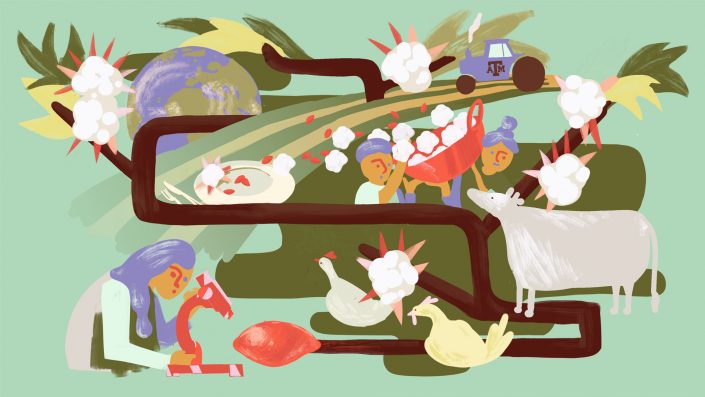USDA approves edible cottonseed that could feed millions globally

Image: Melissa Butcher, Research Communications
Growing cottonseed that can deliver protein to millions of people, a project to which a Texas A&M AgriLife Research scientist has devoted more than half his professional career, is one step closer to reality.
“Our approach, based on the removal of a naturally occurring toxic compound from the cottonseed, not only improves its safety but also provides a novel means to meet the nutritional requirements of the burgeoning world population,” said Keerti Rathore, professor, Department of Soil and Crop Sciences, College of Agriculture and Life Sciences, and plant biotechnologist, Institute for Plant Genomics and Biotechnology, Texas A&M AgriLife Research
Rathore recently received word that the U.S. Department of Agriculture’s Animal and Plant Health Inspection Service, or APHIS, approved Texas A&M’s “Petition for Determination of Non-regulated Status for Ultra-Low Gossypol Cottonseed (ULGCS) TAM66274.”
Through a project funded by Cotton Incorporated, Rathore and the Texas A&M team have developed a transgenic cotton plant – TAM66274 – with ultra-low gossypol levels in the seed that maintains normal plant-protecting gossypol levels in the rest of the plant.
“The kernels from the safe seed could be ground into a flour-like powder after oil extraction and used as a protein additive in food preparations or perhaps roasted and seasoned as a nutritious snack,” Rathore said.
The recent USDA action confirms that TAM66274 and any cotton lines derived from crosses between TAM66274 and conventional cotton or biotechnology-derived cotton granted non-regulated status by APHIS are no longer considered federally regulated articles, he said.
Rathore’s research has been reported in many peer-reviewed science journals and he has been granted several U.S. patents. In 2006, he published in the Proceedings of the National Academy of Sciences announcing the cotton plants had been successfully altered in the lab to “silence” gossypol in the seed. In 2009, field trials verified the lab and greenhouse studies indicating the crop could become a source of protein.
The cottonseed from these plants met World Health Organization and Federal Drug Administration standards for food consumption, he said, thus opening the potential to make the new source of high-protein food available to hundreds of millions of people a year.
Rathore said cottonseed, with about 23 percent protein content, can play an important role in human nutrition with the gossypol eliminated, especially in countries where cereal-based and tuber-based diets provide most of the calories but are low in protein content.
“Growing up in rural India as the son of a doctor, I had seen the effects of malnutrition firsthand in my father’s patients,” he said. “Many of their health issues were due to inadequate food and nutrition.”
Rathore said for every pound of cotton fiber, the plant produces about 1.6 pounds of seed. The annual global cottonseed production equals about 48.5 million tons.
Cotton will continue to be grown as a source of natural fiber, Rathore said, but the adoption of the ultra-low gossypol varieties by farmers has the potential to make the seed just as valuable as the lint.

